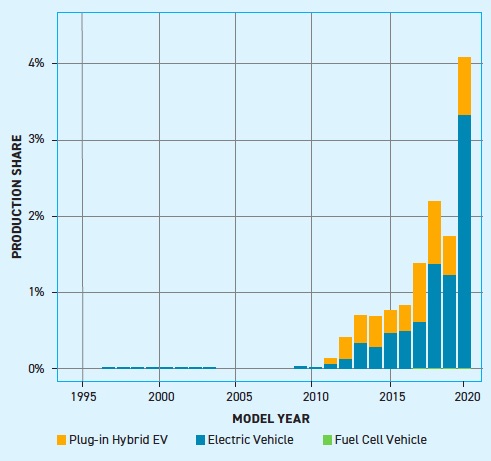The 2020 EPA Automotive Trends Report1 is available, and, as usual, it is a treasure trove of data on the recent evolution of the automobile industry. For the second year in a row, Tesla is the only all-electric vehicle manufacturer represented in the data. Nevertheless, one of the most interesting recent developments is the rate of growth in the sales of electric vehicles (EVs) in the U.S.
Figure 1, reproduced here, depicts the total production share of plug-in hybrids, battery-powered EVs and fuel cell vehicles. Note that the share of fuel cell vehicles is almost negligible, and the share of plug-in hybrids is nearly constant over the last several years. EVs, however, have gained share at an exponential rate. The three main barriers to widespread adoption of EVs are high initial cost, limited range and long charging times.
 Figure 1. The total production share of plug-in hybrids, battery-powered EVs and fuel cell vehicles. Figure reproduced by permission from U.S. Environmental Protection Agency (EPA) (June 2021), “The 2020 EPA Automotive Trends Report: Greenhouse Gas Emissions, Fuel Economy, and Technology since 1975,” p. 52.
Figure 1. The total production share of plug-in hybrids, battery-powered EVs and fuel cell vehicles. Figure reproduced by permission from U.S. Environmental Protection Agency (EPA) (June 2021), “The 2020 EPA Automotive Trends Report: Greenhouse Gas Emissions, Fuel Economy, and Technology since 1975,” p. 52.
High initial cost has been at least partially offset by a combination of economies of scale as more manufacturers launch EV platforms, large-scale battery manufacturers come online, and government subsidies are offered to customers. The subsidies are, in many cases, being reduced or phased out, as they were intended to be temporary measures to incentivize the industry. This strategy seems to have paid off, as the initial cost of some EVs are seen as competitive with internal combustion engine cars.
EV range also has improved dramatically. According to the U.S. EPA,
1 “In model year 2019, the average new EV is projected to have a 252-mile (405 km) range, or about three and a half times the range of an average EV in 2011.” The automotive tribologist can share credit with the battery engineers for this development, as managing friction in the gears and motors has increased the efficiency of EVs, adding to their range. Progress still needs to be made, however, on optimizing gear fluids and coolants for EVs.
Less progress has been made, in the minds of consumers, on the problem of charging time. The main problem here is basic physics—the more electric power pushed through wires of finite resistance, the more heat is generated. Heat is the enemy of battery life, and the effect of fast charging on battery degradation is well documented.
2 With the increased range now available, most drivers are finding they can drive the vehicle during the day and charge the battery overnight, when electricity rates are typically low. For longer trips, the availability of charging stations, and the time to charge, remain concerns.
The final numbers for 2020 are not in yet, and the global pandemic has upended so many of our expectations that the total effect on the automobile industry is still uncertain. However, it looks like EVs have reached a tipping point and are destined to become the dominant powertrain in the foreseeable future.
REFERENCES
1.
U.S. Environmental Protection Agency (EPA) (June 2021), “U.S. Environmental Protection Agency Report EPA-420-R-21-003, The 2020 EPA Automotive Trends Report: Greenhouse Gas Emissions, Fuel Economy, and Technology since 1975.”
2.
Click
here.